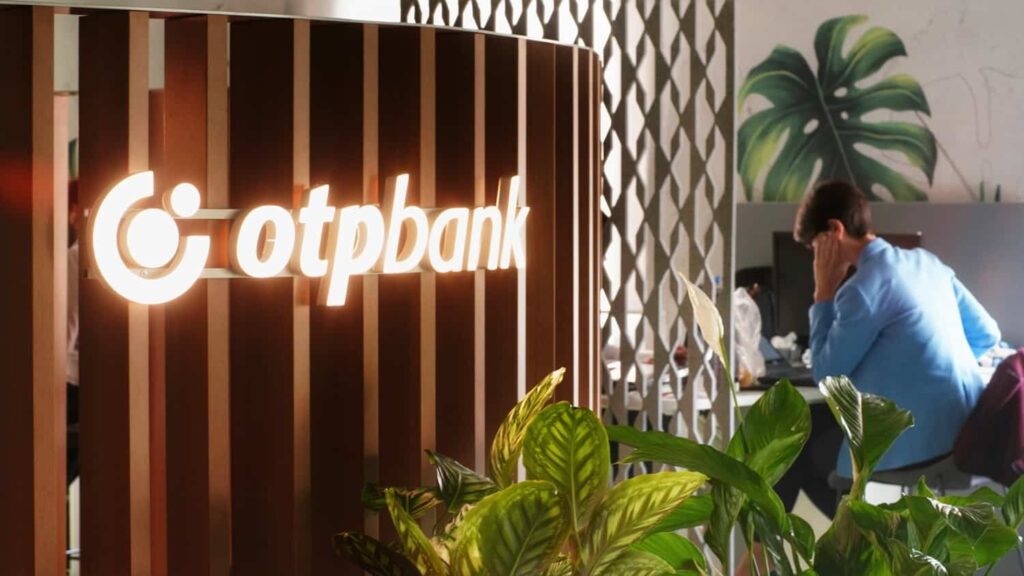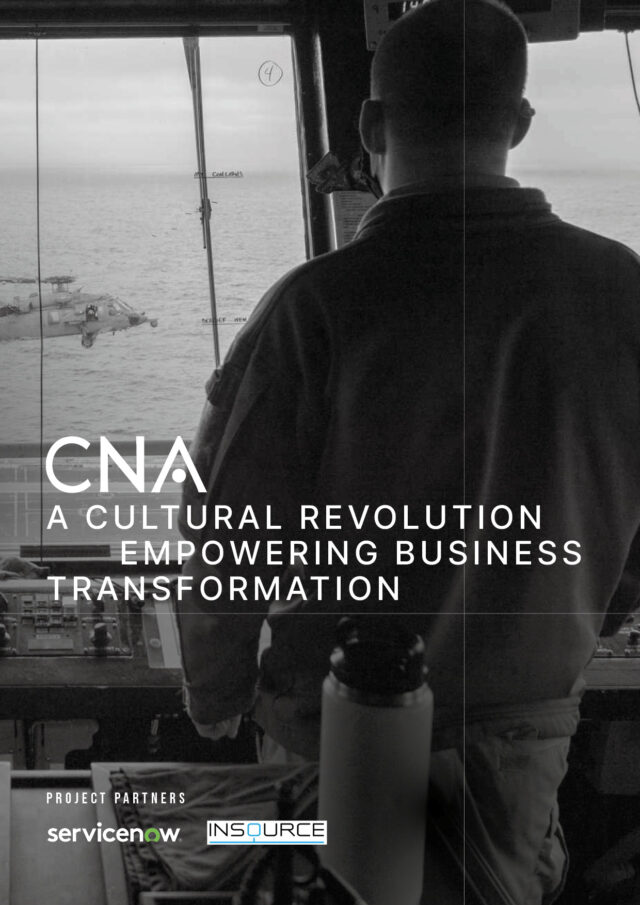A digital transformation is as much about altering the mindset and actions of humans as it is the implementation of new digital infrastructure, software and operations. A workforce, and a working culture, that embraces change and harnesses its potential, is integral to any digital transformation. To create a fertile environment in which to grow a business and its digital operations requires a bold and creative approach. For a company to become truly free, flexible and agile in its operations, there needs to be a culture of trust at every level of the organisation.
Constantin Mares is Executive Director of OTP Bank Romania, responsible for the IT, PMO and Transformation Offices. Constantin is an experienced technology leader within the banking sector, having worked with ING among others. He is a firm believer that an engaged and motivated workforce, one that is aligned, and committed to a digitally-led working strategy, is key to unlocking the potential of any forward-thinking enterprise.
When Constantin took on his current position at OTP, his first assignment was to strengthen the IT function ahead of a major transformation programme. Increasingly, OTP was finding that the standard waterfall methodology was holding the bank back from realising its full potential. “We were having especially big projects constantly delayed, and over budget,” he explains from his Bucharest office. “We soon realised that if we wanted to be successful – and we desperately want to be successful – we had to break the silos and have a better collaboration between the business and the support units at the back. We had to bring faster new features and products for our clients, to be closer to their needs so our projects would create value for them faster.”

One of the first major challenges facing Constantin was the establishment of a team that could help deliver the transformation. At that moment, the whole IT department consisted of around 30 people. But the need for change was there because of changes in the market, changes in the banking regulations as well as the demands of the IT department. The colleagues from the team were high-calibre professionals, highly skilled and experienced, but they were overwhelmed by the numerous projects and activities. They needed to receive help at similar level of expertise.”
Constantin went to work establishing a management team of 11 to cover all units consisting of business & process analysts, programmers & workflow developers, data analysts, project managers, process analysts, DBAs, network and infrastructure specialists. “United as a management team we were able to overcome the inherent difficulties of any transformations or turn-arounds. Moreover, we were crazy enough to still enjoy our roller-coaster adventure.” OTP then started to recruit for new people able to deliver change to a high level of expectation.
IT recruitment in Romania is notoriously difficult. “To hire very skilled people was seen by the CEO as mission impossible,” Constantin explains. “However, we enjoyed very good cooperation with our HR partners who went to work on the job descriptions and our advertising campaigns, which were very simple and straightforward, making it very clear what we needed. We highlighted the challenge and the ambitions we had ahead of us as well as the exciting projects.” Within a year, Constantin already doubled the team and now, nearly two years on, the team has tripled in size.
Recruitment is hard enough, but often the biggest challenge is the onboarding and integration of these new people into a rapidly changing workplace. “The core of the team was a minority all of the sudden,” he says. “But our managers and senior colleagues helped the new arrivals understand the complex new environment around us. And of course, the new people were avid to learn and very eager to contribute to the new environment.”
A culture of trust
The working culture at OTP initiated a vibe of collaboration, fostering a fail-fast-to-succeed strategy. “We wanted to be open, to ask for feedback, to allow people to make mistakes and try new things,” Constantin explains. “We were able to instil this trust in our people. We become a place where people can transparently discuss with their managers about issues or barriers preventing them to achieve our objectives. I think this was one of the key success factors in achieving this transformation.”
A new 360-degree feedback system was introduced with staff being asked to address what they should start doing, what they should stop doing, and what they should continue doing. According to Constantin, this method of giving and receiving feedback was instrumental in creating and strengthening that trust base, essential in any successful organisation. “When you have this kind of trust, people are more comfortable to try things, to make decisions, to be great,” he enthuses. “Because people like to be great. People like to be successful and to achieve. So, we started to empower the team more. Instead of managers telling them what to do they would now tell us what to do. We would no longer impose from above regarding the best way for them to go about things. This completely changed our priorities and people are now much more enthusiastic because they feel appreciated, engaged and involved. We can now achieve results faster and it’s more fun and fulfilling for us.”

The launch of Apollo
“Apollo program was two-fold,” Constantin explains. “First, we wanted to double our market share and grow significantly in our business segments. The other side was a transformational view of the way it was working and adopting practices from Agile methodologies. That’s why we formed Apollo, where we addressed the business efficiency and the sales processes while initiating the visualisation aspect of the bank. We wanted to be more present and closer to our online clients to create a better customer experience.”
Apollo saw OTP moving into a unified digital strategy, freeing the company up from traditional silos and outmoded ways of thinking and working. A new spirit of collaboration linked the different departments as more and more people bought into the new joined-up approach. Constantin and his team could then look into procuring the tools and software needed to realise their new ambitions. “First of all, we looked at the tools we needed in IT to be able to secure this growth. We invested heavily in infrastructure and upgraded our core banking system, and changed the set-up, the operating system and database system (end-of-day and end-of-month processes run now 6 times faster than before). We replaced more than 1,400 user workstations. We migrated our data center into a tier 4 professional data center with redundant and dual-powered instances of servers, storage, network links and power cooling equipment. Then we upgraded the communication infrastructure (including the remote access capabilities) and security infrastructure. We started with our own processes such as the Demand Management Process and made the decision to adopt JIRA. Many local branches received technological refits, bringing them up to date with modern banking.
The organization was enhanced created new functions for test management, IT relationship management, IT asset and contract management, RPA developers or BPM developers. To make sure this rapid growth is sustainable on long run, we created an elite squad of IT architects. We also created a Transformation Office staffed with Scrum masters, Lean 6 Sigma Black Belts and Agile coaches.”
These organizational and technological advancements were quickly embraced and highly appreciated by business departments. They facilitated for much better understanding between departments with greater transparency when it came to requests for investment. “They (business groups) stopped challenging every proposal or solution they received from IT,” says Constantin. “We went from business having to ask for an application, to an understanding of the business need and the solution proposed. They started to trust us to provide them with the solution. We went from the status of service provider to status of trusted business partner.”
Historically, sales and front office staff faced a myriad of applications that they had to know and understand just to engage with the customer and so this was duly shelved in favour of a more linear approach to reduce the time spent in back-office activities, when they could be more customer facing. “This was because our front offices were engaged in redundant activities, or non-value-added activities,” Constantin explains.
“Our growth strategy required a new set of tools and a different approach. The goal of the transformation was to significantly improve productivity and efficiency of the customer-facing employees by consolidating applications, automating processes and visualising customer data and insight. This became our second transformation pillar, after strengthening the IT infrastructure. We had a wide range of business needs that it wanted to meet with a help of a next-generation technology. We evaluated numerous software solutions available on the market and opted for Creatio as the best fit for their business. The combination of the system’s low code, process automation, and CRM technology ticked all boxes for us.

The core project task was focused on streamlining a wide range of front-office and middle-offices processes. Since the scope was extensive, the delivery was divided into several stages. The first delivery stage covered some of the key business needs such as creating a 360-degree customer profile, setting up product catalogue, optimising opportunity management processes, and automating consultation processes.
Delivery 2 was dedicated to automating the processes related to current account opening for individuals. Upon delivery 3 phase, the system was integrated with Enterprise Content Management software, which allowed for unified document management.
Creatio solutions helped us deliver the large-scale digital transformation project effectively. The new approach allowed the project implementation team to test new functionality, gather valuable feedback, and make needed changes at any stage. Thanks to the intuitiveness of the user interface and the ease-of-use of Creatio’s solutions, the bank was able to achieve a high level of user adoption at an accelerated pace. In addition to that, the bank has embraced low-code development approach. Low-code technology allows for modifying the processes quickly and adjusting them to the ever-changing business needs without heavy reliance on deep technical skills.
The third transformation pillar was, according to Constantin, the most important. The move from traditional bricks and mortar banking to a more digitalized customer journey was now seen as a standard requirement for OTP and the team started to think about how they could enhance each layer of OTP for its customers. “Having a solid base for growth and having internal inefficiencies sorted out, it was time to take care about our customers and improve their experience starting with their very first step: onboarding into OTP. FintechOS’ capabilities turned out to be well-suited for our business needs, supporting the deployment of an automated, end-to-end digital onboarding customer journey very fast. The new solution delivers and automatically manages the entire customer facing and back office workflows that we need for a smooth onboarding experience. And we are planning to implement new digital customer journeys using FintechOS technology in the next months and years to accelerate digital transformation success.
“For our customers, first impressions count, so we were very excited to roll out FintechOS’s onboarding solution. And, hitting the market in such a short time is a great achievement.
It also helped implement an enterprise service bus (ESB), which in terms of IT architecture, is a major achievement,” says Constantin. The ESB has given OTP much more agility and flexibility with regards to communication between applications and departments.
Another example is the enhancement of securities investment services for private banking and affluent banking customers. We moved ahead and selected Dorsum, Hungarian solution provider and implemented its advisory facing solution, the Wealth Management Platform. Dorsum designed the functional scope of the platform together with the private and affluent business areas. In line with business and operational goals of the Bank, functional capabilities of the new digital solution help the advisors to have a real-time 360 degrees view of the client portfolios, detailed overview of transaction history, portfolio performance and investment costs (fees paid), to seamlessly communicate with the clients, to build tailor-made advisory and client meeting workflow. Of course, all of these fully in line with the regulatory requirements, such as eg. MiFID2.
The new digital solution is able to improve the quality and accuracy of the advice, make the advisory and client meeting workflow faster and the KPIs and effectiveness of the advisors measurable.
We continuously simplified our star products and we were among the first banks in Romania to introduce new payment methods: ApplePay and OTPay for Android platform. We also launched new simplified versions of Internet and mobile banking to allow our customers a smoother interaction with OTP.
The data warehouse
The fourth pillar of transformation saw the installation of a new data-driven ‘backbone’. OTP invested in a data warehouse system and started to implement its visualisation by using data in making decisions. “. We believe and I believe that in this century, using data is key. We need to make fast and informed decisions. We created a single version of truth, augmenting all the data from all different systems into one warehouse. We also invested in a visualization layer. We now use Tableau when presenting the data to the organisation.”
With a project of this magnitude and complexity, partners are essential to OTP’s success, something Constantin is keen to stress. OTP decided to rely on core strengths of such partners implementing new EU directives of PDS2 SCA in 2019. We created a strong cooperation between OTP and SMP Solutions that resulted in an adequate solution of providing two-factor authentication method for our customers. With the help of SMP Solutions we were able to deliver in time new hardware tokens to our customers and we have created the possibility of using mobile token application in order to move towards to digital transformation and create higher customer satisfaction.”
“As SMP Solutions is committed in digital solutions, we will ensure together an intelligent branch queueing and ticketing system in order to optimise the waiting time and the personal interactions at the branches,” Constantin enthuses. “The new solution will assist our customers to reserve timeslots remotely for personal appointments, while serving their convenience we will be able to ensure their safety more effectively during the period of COVID-19.”
The value of a great partnership really hit home earlier this year when lockdown struck in Romania. OTP’s work with Dell Technologies and SMP Solutions over the previous two years had placed the bank in a comparatively comfortable position when the pandemic struck with the digital backbone of the bank continuing to operate as if they were back in the office. “On the infrastructure side we like SMP Solutions, which is a partner of Dell Technologies in this infrastructure area,” Constantin explains. “The fact that we achieved this in a very short time frame – in two weeks we had 97% of the people from headquarters working from home – is also attributable to our partners from Dell Technologies and SMP Solutions. They immediately understood what was going on. They were standing next to us and helped us in these crazy times.”
In terms of how OTP addressed or reacted to the pandemic, are there any learnings that have happened during this time that Constantin might take forward with him, post COVID? “Yeah, I would say it was very interesting to see how the mindset and people’s behaviour adapted so quickly when we went through a crisis period.” It was felt by some at OTP that working from home, in a paperless environment just wouldn’t work. “However, in a matter of weeks, guess what? Business functions were increasing following a decrease in month three. By July, we were back on track and even above the levels before the pandemic. We are still working with no paper, and we are still working from home and I would say this is an important take away. I mean every crisis has opportunities and I think this was the opportunity resulting from this particular crisis.”
Another key takeaway of this period for Constantin is the new level of understanding between managers and their teams. Again, it goes back to this culture of trust. “I think it’s very important that the management comes to the people, understands their problems and takes decisions to support the teams,” says Constantin. “The management team cares about the health and the wellbeing of the people and so provided some specialised client psychologists for our people should they need to call such a person.”

Bolstered by a new digital backbone and organisational structure OTP is now able to research and develop new products at speed, including the recent chatbot. “In three weeks, we launched this chatbot with end-to-end integrations from the website, in which the customer could go through the process in a completely automated way, rather than interacting with a call centre operator. This channel was used by 55% of the clients asking for a debt release, a significant number. We were not estimating such a big success or such a big impact for a newly launched channel, but it was very easily embraced by the customer (having more than 60,000 interactions in less 3 months). This mindset shift also applied to our business colleagues would not even dare to believe that the implementation could be done in such a short time frame nor that such an implementation would have such a big success for the client.”
OTP is now a much more agile and flexible enterprise, fuelled by an intoxicating spirit of collaboration, creating new products at speed and seamlessly attracting and onboarding new clients through its state-of-the-art customer journey. It’s clearly an environment that has engaged Constantin. “To work in such a rapidly growing environment and to be able to implement transformations on so many levels is very fulfilling for me, because I get to apply all my management experience, all my banking experience, and people skills all at once. We have so many things to do that it is very fulfilling for me and something I’m enjoying a lot. To see this change in the culture of the organisation, to see people more open, more vibrant and happier at work is a good accomplishment and a great motivation for me and my work at OTP.”









